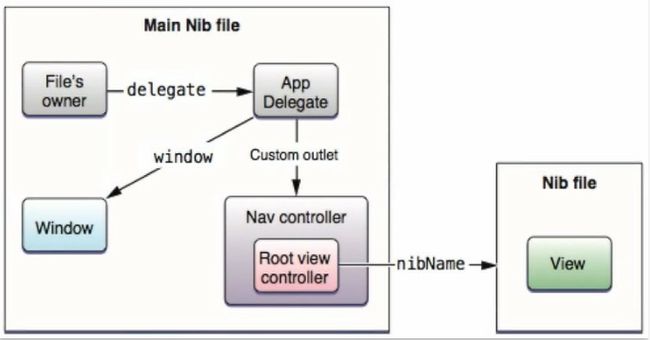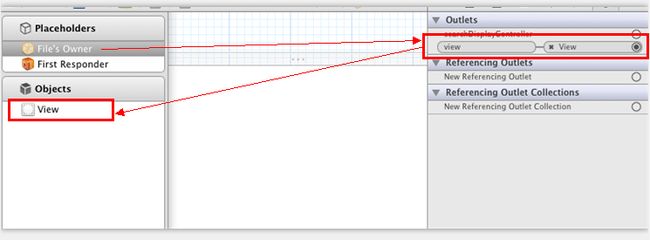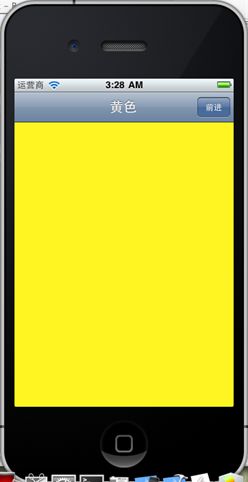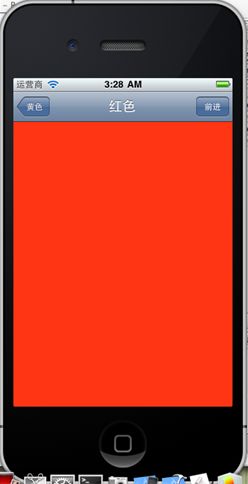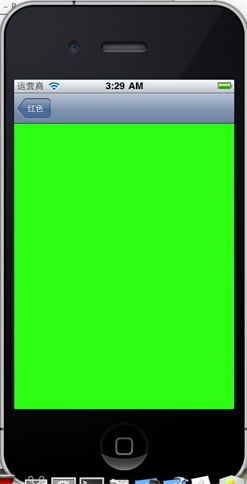iphone视图间跳转之三:导航栏控制器
导航控制器是UINavigationController作为根控制器,根试图控制器是根控制器控制的第一个试图,作为启动第一次加载的试图。而且只有在导航控制器中才有根试图控制器之称。所以根控制器与根试图控制器有本质的区别,程序可以从根试图控制器发起其它试图。
下面看看导航栏控制器的原理图:
导航控制器它们的试图是由一个栈结构来管理,这个和Android里面的Activity栈类似。
我们现在来看看导航栏控制器试图跳转的代码实现步骤:
1、创建一个Navigation-based Application的控制器类,由于导航栏控制器常常和表试图搭配用,所以在生成的根试图控制器默认继承UITableViewController。为了简单起见,我先让这个根试图控制器继承普通的试图控制器UIViewController。
UITabBarController是控件的视图控制器,可以作为根控制器,这里我将介绍标签栏控制器来实现视图之间的跳转。
2、点击RootViewController,删除默认表试图,创建新的普通视图,然后按下图连线,如下图
3、创建其它普通视图,在视图跳转的过程控制中,下面的代码分成连线的方式与代码方式注册前进按钮
运行结果如下图:
程序运行出现黄色试图——>红色试图——>绿色试图
代码:
RootViewController.h
#import <UIKit/UIKit.h>
#import "GreenViewControl.h"
#import "RedViewControl.h"
@interface RootViewController : UIViewController
{
GreenViewControl * green;
RedViewControl* red;
}
@property(nonatomic,retain) GreenViewControl* green;
@property(nonatomic,retain) RedViewControl* red;
-(IBAction)moveToNextView:(id)sender;
@end
RootViewController.m
#import "RootViewController.h"
@implementation RootViewController
@synthesize red;
@synthesize green;
-(IBAction)moveToNextView:(id)sender
{
RedViewControl* redCV = [[RedViewControl alloc] initWithNibName:@"RedViewControl" bundle:nil];
self.red = redCV;
[redCV release];
[self.navigationController pushViewController:self.red animated:YES];
}
- (void)viewDidLoad
{
[super viewDidLoad];
}
- (void)viewWillAppear:(BOOL)animated
{
[super viewWillAppear:animated];
}
- (void)viewDidAppear:(BOOL)animated
{
[super viewDidAppear:animated];
}
- (void)viewWillDisappear:(BOOL)animated
{
[super viewWillDisappear:animated];
}
- (void)viewDidDisappear:(BOOL)animated
{
[super viewDidDisappear:animated];
}
/*
// Override to allow orientations other than the default portrait orientation.
- (BOOL)shouldAutorotateToInterfaceOrientation:(UIInterfaceOrientation)interfaceOrientation {
// Return YES for supported orientations.
return (interfaceOrientation == UIInterfaceOrientationPortrait);
}
*/
// Customize the number of sections in the table view.
- (NSInteger)numberOfSectionsInTableView:(UITableView *)tableView
{
return 1;
}
- (NSInteger)tableView:(UITableView *)tableView numberOfRowsInSection:(NSInteger)section
{
return 0;
}
// Customize the appearance of table view cells.
- (UITableViewCell *)tableView:(UITableView *)tableView cellForRowAtIndexPath:(NSIndexPath *)indexPath
{
static NSString *CellIdentifier = @"Cell";
UITableViewCell *cell = [tableView dequeueReusableCellWithIdentifier:CellIdentifier];
if (cell == nil) {
cell = [[[UITableViewCell alloc] initWithStyle:UITableViewCellStyleDefault reuseIdentifier:CellIdentifier] autorelease];
}
// Configure the cell.
return cell;
}
/*
// Override to support conditional editing of the table view.
- (BOOL)tableView:(UITableView *)tableView canEditRowAtIndexPath:(NSIndexPath *)indexPath
{
// Return NO if you do not want the specified item to be editable.
return YES;
}
*/
/*
// Override to support editing the table view.
- (void)tableView:(UITableView *)tableView commitEditingStyle:(UITableViewCellEditingStyle)editingStyle forRowAtIndexPath:(NSIndexPath *)indexPath
{
if (editingStyle == UITableViewCellEditingStyleDelete)
{
// Delete the row from the data source.
[tableView deleteRowsAtIndexPaths:[NSArray arrayWithObject:indexPath] withRowAnimation:UITableViewRowAnimationFade];
}
else if (editingStyle == UITableViewCellEditingStyleInsert)
{
// Create a new instance of the appropriate class, insert it into the array, and add a new row to the table view.
}
}
*/
/*
// Override to support rearranging the table view.
- (void)tableView:(UITableView *)tableView moveRowAtIndexPath:(NSIndexPath *)fromIndexPath toIndexPath:(NSIndexPath *)toIndexPath
{
}
*/
/*
// Override to support conditional rearranging of the table view.
- (BOOL)tableView:(UITableView *)tableView canMoveRowAtIndexPath:(NSIndexPath *)indexPath
{
// Return NO if you do not want the item to be re-orderable.
return YES;
}
*/
- (void)tableView:(UITableView *)tableView didSelectRowAtIndexPath:(NSIndexPath *)indexPath
{
/*
<#DetailViewController#> *detailViewController = [[<#DetailViewController#> alloc] initWithNibName:@"<#Nib name#>" bundle:nil];
// ...
// Pass the selected object to the new view controller.
[self.navigationController pushViewController:detailViewController animated:YES];
[detailViewController release];
*/
}
- (void)didReceiveMemoryWarning
{
// Releases the view if it doesn't have a superview.
[super didReceiveMemoryWarning];
// Relinquish ownership any cached data, images, etc that aren't in use.
}
- (void)viewDidUnload
{
[super viewDidUnload];
// Relinquish ownership of anything that can be recreated in viewDidLoad or on demand.
// For example: self.myOutlet = nil;
}
- (void)dealloc
{
[red dealloc];
[green dealloc];
[super dealloc];
}
@end
RedViewControl.h
#import <UIKit/UIKit.h>
@interface RedViewControl : UIViewController
{
UIViewController* green;
}
@property(nonatomic,retain) UIViewController* green;
-(IBAction)moveToNextView:(id)sender;
@end
RedviewControl.m
#import "RedViewControl.h"
@implementation RedViewControl
@synthesize green;
-(IBAction)moveToNextView:(id)sender
{
UIViewController* greenCV = [[UIViewController alloc] initWithNibName:@"GreenViewControl" bundle:nil];
self.green = greenCV;
[self.navigationController pushViewController:self.green animated:YES];
}
- (id)initWithNibName:(NSString *)nibNameOrNil bundle:(NSBundle *)nibBundleOrNil
{
self = [super initWithNibName:nibNameOrNil bundle:nibBundleOrNil];
if (self) {
// Custom initialization
}
return self;
}
- (void)didReceiveMemoryWarning
{
// Releases the view if it doesn't have a superview.
[super didReceiveMemoryWarning];
// Release any cached data, images, etc that aren't in use.
}
#pragma mark - View lifecycle
- (void)viewDidLoad
{
[super viewDidLoad];
self.navigationItem.title = @"绾㈣壊";
UIBarButtonItem* nextButton = [[UIBarButtonItem alloc] initWithTitle:@"鍓嶈繘" style:UIBarButtonItemStyleBordered target:self action:@selector(moveToNextView:)];
self.navigationItem.rightBarButtonItem = nextButton;
[nextButton release];
// Do any additional setup after loading the view from its nib.
}
- (void)viewDidUnload
{
[super viewDidUnload];
// Release any retained subviews of the main view.
// e.g. self.myOutlet = nil;
}
- (BOOL)shouldAutorotateToInterfaceOrientation:(UIInterfaceOrientation)interfaceOrientation
{
// Return YES for supported orientations
return (interfaceOrientation == UIInterfaceOrientationPortrait);
}
-(void) dealloc
{
[green dealloc];
[super dealloc];
}
@end
GreenViewControl.h
#import <UIKit/UIKit.h> @interface GreenViewControl : UIViewController @end
GreenViewControl.m
#import "GreenViewControl.h"
@implementation GreenViewControl
- (id)initWithNibName:(NSString *)nibNameOrNil bundle:(NSBundle *)nibBundleOrNil
{
self = [super initWithNibName:nibNameOrNil bundle:nibBundleOrNil];
if (self) {
// Custom initialization
}
return self;
}
- (void)didReceiveMemoryWarning
{
// Releases the view if it doesn't have a superview.
[super didReceiveMemoryWarning];
// Release any cached data, images, etc that aren't in use.
}
#pragma mark - View lifecycle
- (void)viewDidLoad
{
[super viewDidLoad];
self.navigationItem.title = @"缁胯壊";
// Do any additional setup after loading the view from its nib.
}
- (void)viewDidUnload
{
[super viewDidUnload];
// Release any retained subviews of the main view.
// e.g. self.myOutlet = nil;
}
- (BOOL)shouldAutorotateToInterfaceOrientation:(UIInterfaceOrientation)interfaceOrientation
{
// Return YES for supported orientations
return (interfaceOrientation == UIInterfaceOrientationPortrait);
}
@end
